| Photojournal
- 14
August 2006
More
new toys
|
One of the things that
I really liked about my old CoolPix 995, the camera I used two
cameras ago, was a ring light that I had for it. This light screwed
on to the end of the lens, and had something like six white LEDs
inside a translucent plastic circle ringing the lens. It made
for very nice lighting on close macro shots.
With my recent resurgence
of interest in macro, I had been looking for a ring light to use
with my macro lens. But then, my friend Karla told me about a
new Nikon macro light set that had just come out. It wasn't exactly
a ring light (although if you get a few extra flash units, it
can closely approximate one) but it provided much more flexibility
in macro lighting. It also came with a wireless commander piece
that would control the big flash unit that I already had. I decided
that I had to have one of these sets, and promptly surfed to a
few of my favorite online camera shops and ordered one.
Well, on the 14th,
I got notice that my new macro light set had arrived. I picked
it up at the post office after work, and then stopped by a store
and got the appropriate batteries. At home I unpackaged it all
(there were lots of little pieces), read a minimal amount of the
manual in order to figure out how to operate it, and headed outside
to see what it would do.
The first interesting
little thing I encountered was a yellowjacket on a rhododendron.
The 'jacket was lame and was crawling around slowly on the leaf
rather than walking around quickly, which is more the usual case.
This made him a good first subject, as he didn't get away when
I fiddled with the settings on the camera and flash. Here's my
yellowjacket.
|
|
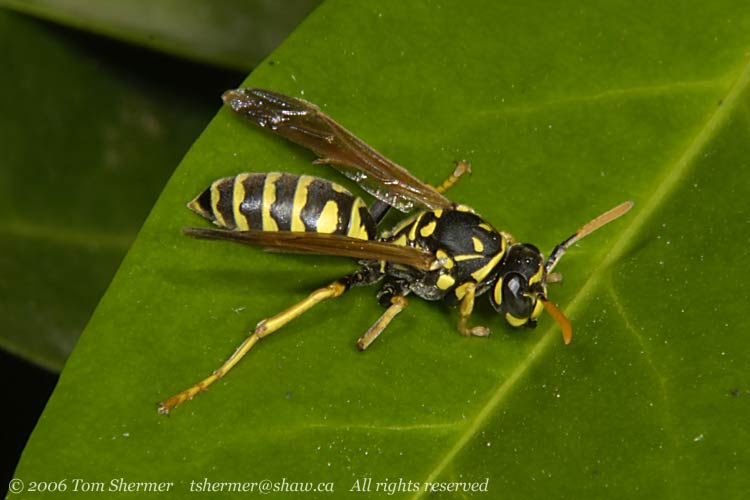 |
|
Now, the light set
includes a plastic ring that attaches to the end of a lens. Onto
this ring, one can mount one or both of the lights in the set.
To attach the ring
to the lens, one needs an adapter for the lens' thread size. The
set comes with several, but none of them were the right size for
my macro lens. Consequently, I was using my general-purpose lens
rather than my macro lens for these photos. To make that lens
macro-capable, I put an extension tube between it and the camera.
It turned out that this combination takes passable macro shots.
My next subject was
an ant who was sipping some liquid from a small flower. I'd suspect
that the liquid is nectar rather than water; ants tend to have
a real sweet tooth.
|
|
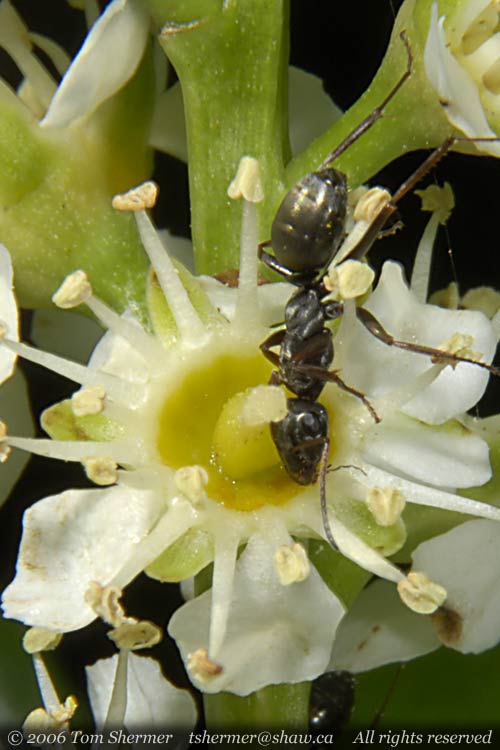 |
|
So far, so good. I
was checking my photos on the little LCD screen on the back of
my camera as I went, and it looked like I was getting decent lighting
with no harsh shadows. Having two lights really helps with that,
as one light can fill in the shadows of the other.
I continued along the
outside of the building, and stopped at one of the many rose bushes
to take a few rose photos. Here one of the challenges is getting
the lights close enough to center so that the middle of the flower
isn't in deep shadow.
|
|
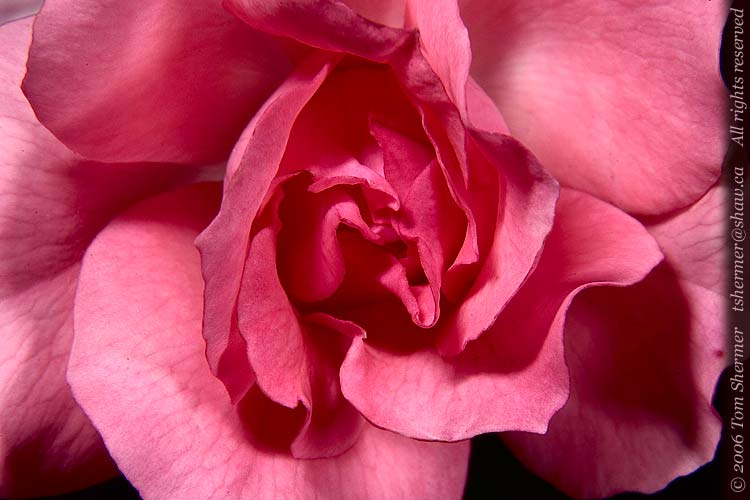 |
|
That turned out to
be fairly straightforward. All I had to do was hold the camera
a little farther back from the flower than I had from the insects,
and aim the lights a little more...straight forward.
Around the side of
the building, I found a little snail on a rhodo. That was pretty
exciting, as snails are neat little guys. He was headed into the
depths of the bush, so I plucked him off and put him out near
the edge. Unfortunately, when I did that, I dropped him and it
cracked his shell a little.
|
|
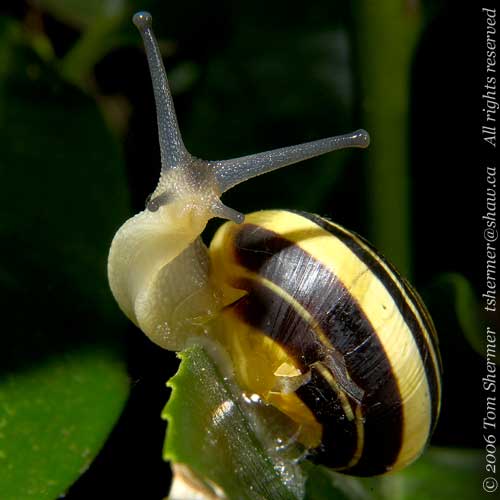 |
|
Snails have the capacity
to generate a sort of cement for repairing their shells when they
get damaged like this, so this fellow will most likely be just
fine...but I still felt pretty bad about having dropped him.
Anyhow, he crawled
around on the leaf for a while, affording me some very nice camera
angles. The lights were doing a pretty good job on him, although
sometimes the reflection I got off his shell was a little borderline.
|
|
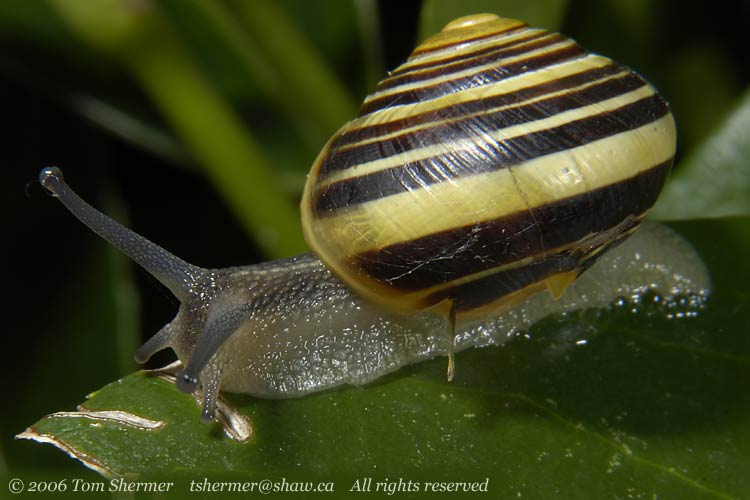 |
| I'm really
fond of snails; the shells and tentacles and all just seem to make
for good photos. Besides which, it's cool that they have their eyes
out there on the end of an appendage that they can move around. |
|
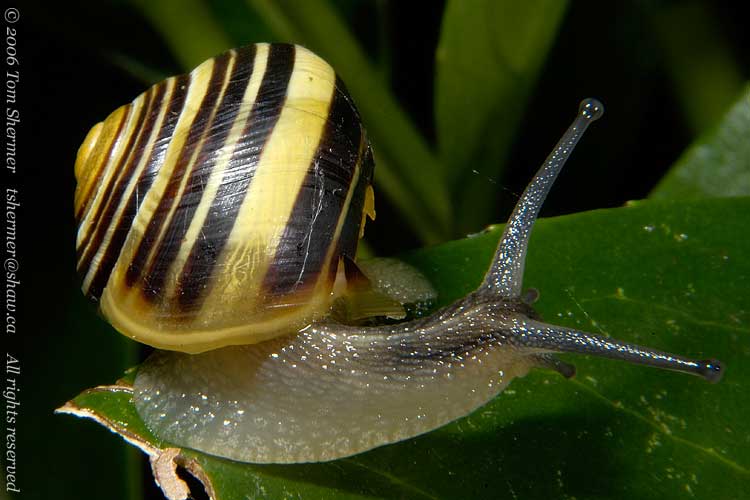 |
|
This particular type
of snail is a Grovesnail (Cepaea nemoralis); they're quite
common in this area, but easy to miss if you're not looking too
closely.
He eventually crawled
back to the other side of the leaf and from there into the middle
of the bush. I took one last shot as he went. This one is probably
the worst-lit of the bunch, but I didn't really have time to set
the lights properly. Snails can move fast (relative to their size)
when they want to.
|
|
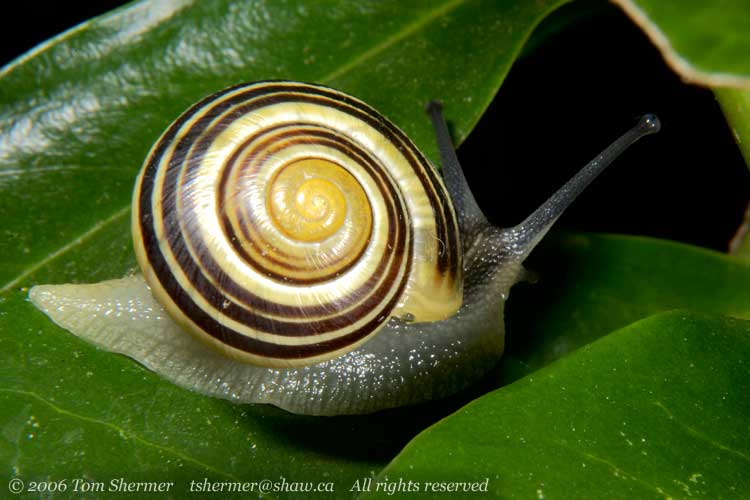 |
| On a nearby
bush, I found a Green Bottle Fly (genus Lucilia). The big
round green metallic body makes these sorts of bottle flies fairly
easy to recognize. |
|
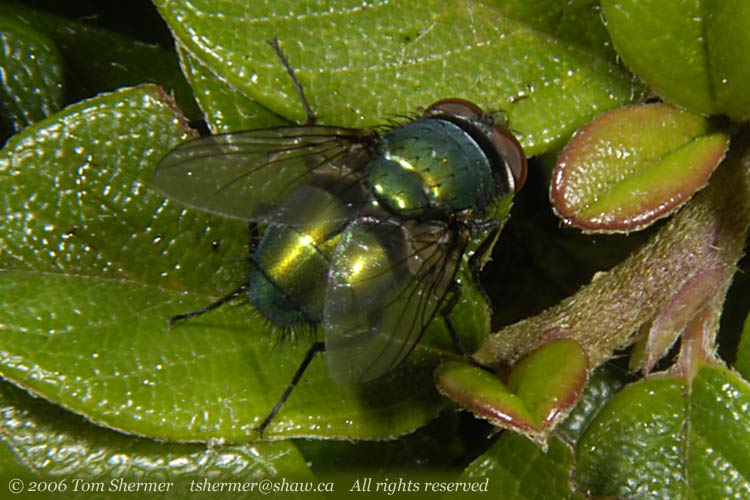 |
|
Bottle flies are a
type of Blowfly, so if you know these guys as blowflies, then
that's right, too.
The general lens and
extension tube combination was good, but it wasn't as easy to
focus as my macro lens, and it also wasn't quite as sharp. So
I did end up with some photos that were a little soft, like the
following one.
|
|
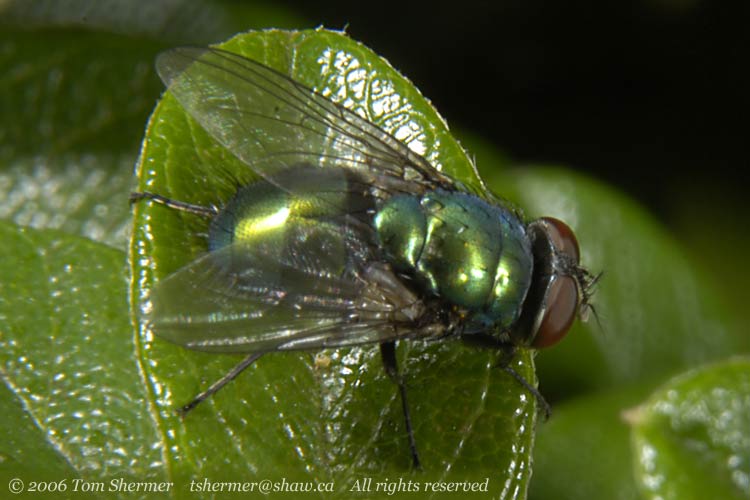 |
| Next I wandered
around from the outside of the building into the courtyard. Just
below the stairs up to my place, I found a little jumping spider
crawling around on a low bush. Here I managed to get a front view,
showing his "face", with the two big eyes in the front
and two little ones beside. You can also see a fifth eye a little
left and above the other four. |
|
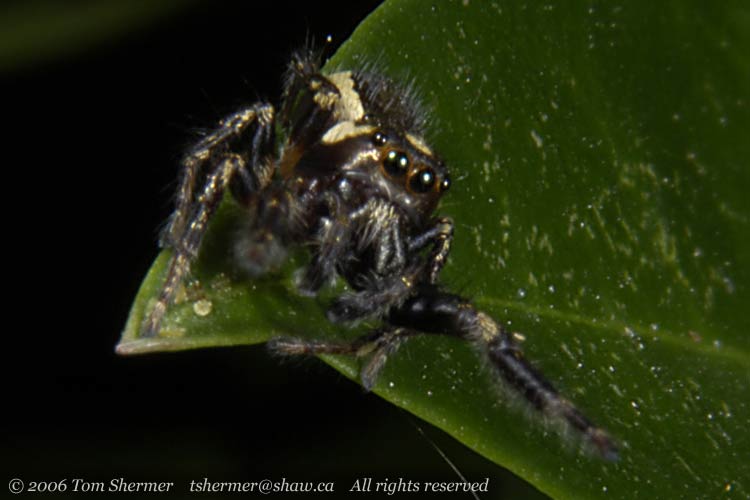 |
|
That wasn't technically
a great photo; it wasn't as sharp as I like, and it showed one
of the real problems that one can have when using two lights:
the eyes have two highlights each. That doesn't generally happen
in real life, as there's only one sun. So, in looking at that
spider's eyes, it's very clear that we're looking at a flash photo.
The dual highlights are quite distracting.
To avoid that problem,
I'd have to take one of the lights off of the lens ring and place
it somewhere else. Unfortunately, jumping spiders have bulging
eyes, so often there's no really good place to put the second
light. Situations like that call for light diffusers to spread
out the second light so it doesn't form a sharp highlight.
Well, after all that
discouraging thought, I did manage to get a placement of spider
and lights that worked. One light here is almost directly above
the spider, on the lens ring. The other light I had placed on
the right, with its power turned down quite a bit.
|
|
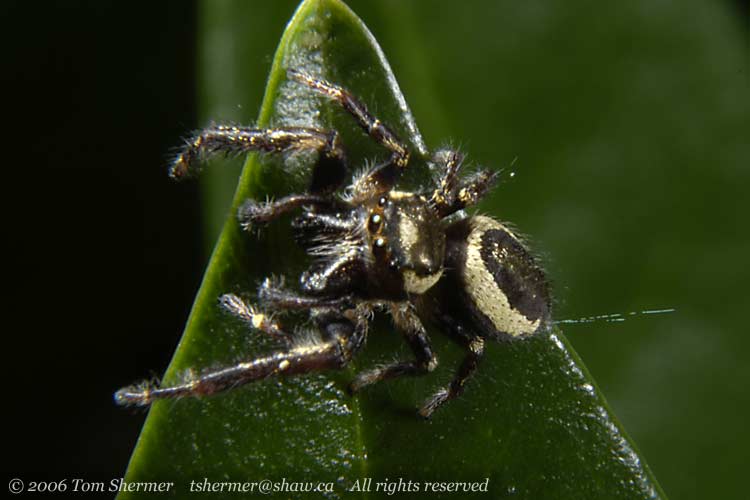 |
| That's another
neat thing about the new light set; it's easy to set the power output
of the lights relative to one another. If you want one lamp to put
out half the light that the other one does, or a third, or a quarter,
it's just a couple of button presses on the wireless command module,
which sits on top of the camera. |
|
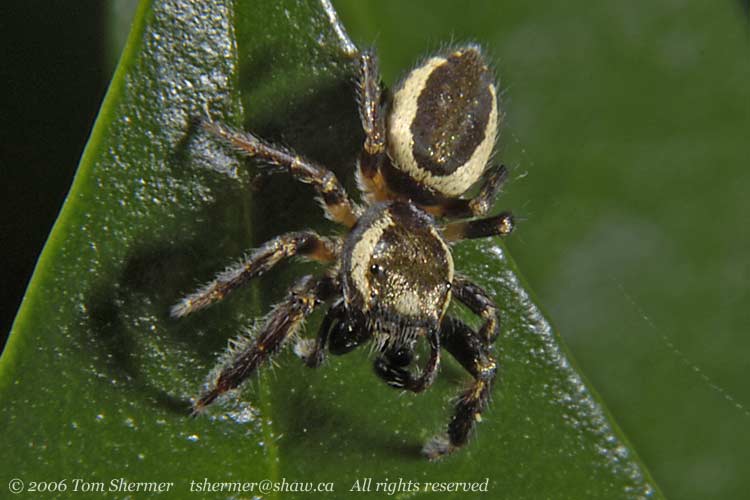 |
|
By the way, I should
tell you that that jumping spider is one from the genus Eris.
I'm sure you wanted to know that.
It was still light
outside, but the entire courtyard was in shadow (which happens
fairly early in the evening, as our building is several stories
tall.) With the flash set, I could ignore the lack of sun, and
so I was able to find several more subjects before heading in.
First up was a red rose.
|
|
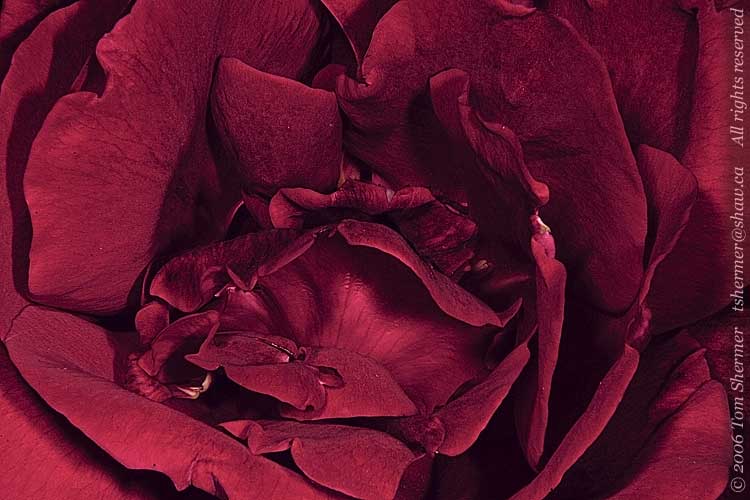 |
| Next was
one of our Garden Spiders, on a web built on the side of a lamppost.
|
|
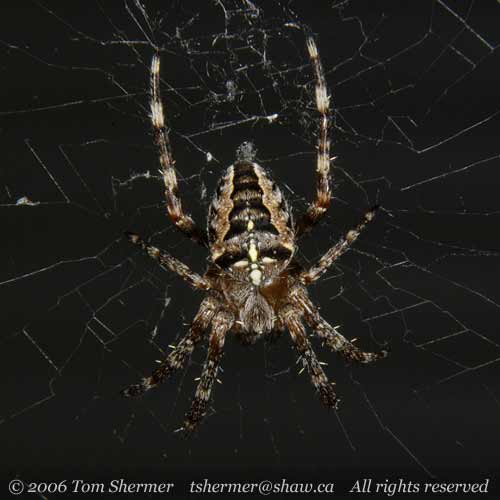 |
| After that,
I noticed these little round things hanging from a tree. We've got
a couple of trees with these things in our courtyard; they're called
Japanese Snowbells (Styrax japonicus). These little globes
may look good, but they actually taste pretty lousy. |
|
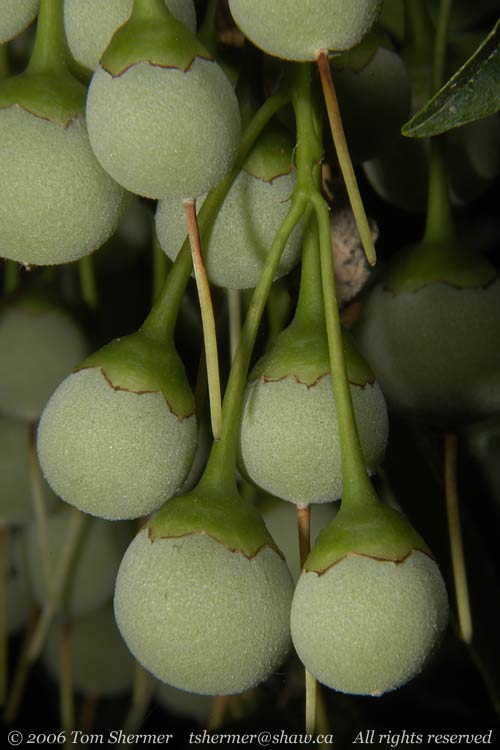 |
|
So if you're planning
on eating one, use lots of barbeque sauce. Better yet, just drink
the sauce and forget the snowbell.
In the planter below
the snowbells, there were some plants with very colorful leaves.
I don't know the type of plant, so it'll have to remain nameless
for now.
|
|
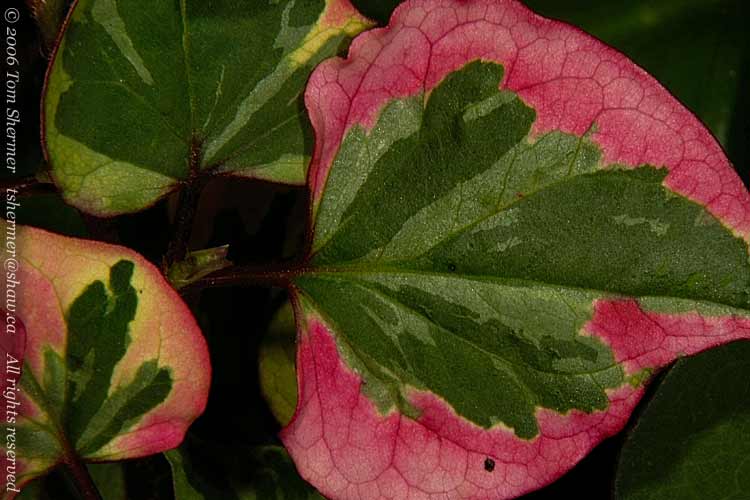 |
| The only
non-macro photos I took were of my friend Mika, who came over for
a brief visit. |
|
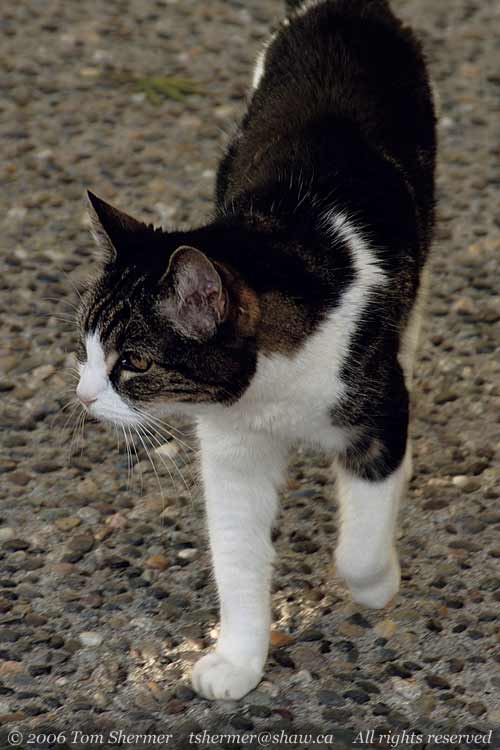 |
|
I don't get to see
her too often, so it was nice that she dropped by.
I ended this first
outing with the light set with a few more of our local spiders.
I think this one is the same species as the previous one,
despite the much lighter coloration.
|
|
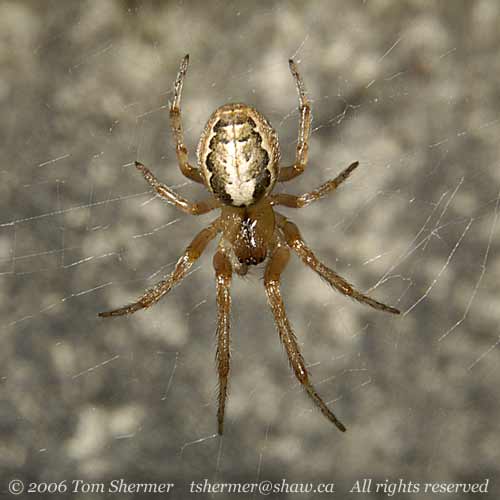 |
|
Where are all of the
arachnologists when you need 'em?
After the spiders,
I went in to have a look at photos so that I could learn what
had worked and what hadn't. It turned out that I had done fairly
well for a first session, which is mostly attributable to how
well-designed the light set really is. I'm sure I'll be having
loads of fun with it in the days and months and years to come.
Enjoying the new toys,
Tom
|
|
|